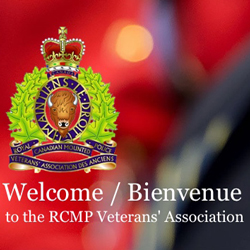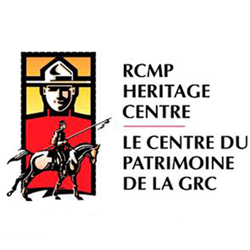John Stolarski’s Old Newspaper Clippings
With the exception of his first two years in the Force, John Stolarski spent his entire career as a Police Dog Services handler.
Throughout this career, John clipped newspaper articles about members who he had worked with.
Despite the fact that John has passed away, his family has agreed for us to re-post these articles for the interest of RCMP Veterans and current members of the Force.
NEW STAFF AT COURTENAY RCMP

Photograph of RCMP Corporal Rob Nichols and his police dog Lance (Source of photo – Daily Free Press Newspaper)
Cpl. Rob Nichols and RCMP tracking dog Lance are now members of the Courtenay subdivision.
Nichols and Lance have been together for more than three years and will now serve the subdivision area in search and other investigative assignments between Parksville and the north end of Vancouver Island.
A FAREWELL SALUTE BY RCMP OFFICERS
The Nanaimo RCMP officer’s group – the Tyee Buffalo Club – held a special farewell barbecue at Nanaimo Fish and Game club facilities Sunday night, at which officers who are retiring or who have been transferred were given commemorative beer mugs as mementos of their service here. As a farewell gesture the men toasted each other’s futures. From left are constable Dave Free, who is transferred to Prince George; Sgt. Ed Malinowski who is transferred to Golden; S/S/Major Ernie Borderud who is retiring; Inspector Dan Webster transferred to Ottawa; S/Sgt. Frank Kilner who is retiring and Cpl. Stan Douglas, who is transferred to Port Hardy.
AJAX BEGINS NEW LIFE AS POLICE SERVICE DOG
Nov. 16, 1976 – Courtenay – Ajax has arrived in Courtenay. He is a soft, warm and cuddly German shepherd pup.
The three-month-old dog is the responsibility of Constable Dave Logan of the Courtenay RCMP detachment for the next 10 to 14 months. During that time he will train the dog in basic commands such as “come, sit, stay, heel and down.”
The dog came to Courtenay by air from Innisfail Alberta, the site of the RCMP dog training school.
When Ajax is mature he will be returned to the dog school and assessed for temperament and ability. If found suitable he will then start the next phase of his training, including tracking, search and guard techniques.
Until now, dogs, usually German shepherds, have been selected from kennels across Canada and puppy training has been carried out in conjunction with 4-H clubs.
Now pups are being kennel-bred at Innisfail. Nine pups were born Aug. 8, 1976. Two are on the lower mainland.
Dog master Bill Van Otterloo of Nanaimo, said the RCMP is starting its own line again and hopes to breed for temperament, intelligence and working ability. One trait, he explains, is of little use without the others.
His dog, Major, is now about one year old and possesses excellent temperament as well as being a good working dog.
During his stay in Courtenay, Ajax will be exposed to all sights, sounds and smells of society.
Constable Logan said dogs raised in a secluded atmosphere tend to become kennel shy and unsatisfactory for working purposes.
All expenses for Constable Logan’s young boarder are paid by the RCMP including food and medical bills. Since most German shepherd dogs grow to about 80 pounds, the food bill can be a major consideration. A well-balanced diet is a necessity for good bone and body growth.
The police service dog must be able to travel in all and any kind of transportation. There are many times when travel is by air, including helicopter, and a dog must take this in stride as part of his working life.
The average life of a police dog is about seven years. During that time he works solely with his dog master and between them there develops a great rapport. Each must learn to trust the other and work as a team.
Constable Logan has set his sights on becoming a dog master and the test for man is as rigid as for dog. it is a 14-week course at Innisfail. 14-weeks of heard work and learning.
If Ajax makes the grade he will become a member of the RCMP complete with a regimental number.
The RCMP takes pride in its dogs and horses as well as its men.
Courtenay residents will watch with interest as Ajax grows and learns what his life is all about.
HE’S MORE THAN A COMPANION: He Saves Lives, Stops Criminals

TRACKING DOG, Rib, and his handler Cpl. John Stolarski. Life is not slow for a police dog and his handler of the variety of duties they are called on to perform (Source of photo – The Arrowsmith Star newspaper).
March 8, 1978 – Police work is for the dogs, some people might say, and in many cases this is true.
Parksvill RCMP called on dog hander Cpl. John Stolarski of Nanaimo and his dog, Rip, to assist in a search for three juveniles who had fled into the bush after being apprehended breaking and entering a house on Pioneer Crescent last Wednesday.
Before John and Rip arrived from Nanaimo, RCMP had the three youths in custody, but prior to his return to Nanaimo, John told the Arrowsmith Star a bit about himself and the dogs he works with.
John has been a member of the RCMP for 19 years, 17 of which have been devoted to training and handling police dogs. He was recently transferred to Innisfail, Alta., where he will be training man and dog teams for police work.
According to John, police dogs are started in training when they are about one-year-old. By this time, he says they are mature and have settled down from puppyhood enough to take their training seriously.
The dog is trained along with the officer who will be his constant handler for the rest of his working days. In some case a man and a dog don’t seem to get along, in which case they are usually separated and the man given a different dog, the dog a different handler.
Sometimes a dog who will not work for one man will work very well for another.
The dog starts his training with basic obedience lessons. He learns to come on command, to sit, lay down and heel when he is told. The handler and the dog get to know one another, and begin their special police training together.
Police dogs are mainly used for tracking, so this is where their training starts. The dog is shown a object, such as a glove, which is tossed a short distance away. When the animal retrieves the object and returns it to his handler, he is rewarded with praise.
The object will be thrown farther and farther away from the dog, until it is thrown out of his vision. Then he must use his nose to find it.
John says as soon as the dog learns to use his nose, rather than his ears and eyes to locate an object, the battle is half over. It is only a matter of time until the animal can be introduced to say, a shirt worn by a child, and follow his nose to the child who has the same scent as the shirt that was shown to the dog.
John’s dog, Rip, was friendly towards the Star reporter while John was nearby, but later, when alone in the car, acted as though he wanted to bite her head off.
John says this is true with most police dogs. When they are with their handlers, they feel whether or not the handler is relaxed. If so, they usually pose no threat to strangers, but when unattended, they are on guard at all times. This does not mean that the dog will attack anyone who comes near.
John says that rather than bite, if a dog is not happy with a person and feels they should not be allowed to pass by, he will usually just grab the person’s arm or leg.
Needless to say, if you have a 100-pound German Shepherd holding on to you leg, you are not going to keep moving just to see if indeed he will bite off your leg.
The dogs, when they are tracking, known the difference between a ‘good guy‘ and a ‘bad guy.’ They sense fear in those who are not glad to see the arrival of a police dog, and understand when the person they have found is an innocent, misplaced person. The latter is usually glad to see the dog.
John pointed out if the handler is unaware of danger from an approaching person, the dog reacts because he senses the tenseness in the world-be attacker.
“It’s not easy to trick a well-trained dog,” says John.
The dog and handler train together at a training camp for three months before going to work together. After the basic training the gain experience and knowledge from on-the-job training. If the pair is not exposed to enough situations they need to gain experience, situations are simulated.
Once a handler and dog have been paired, they stay together for the dog’s active police life, till the dog is about 10-years-old.
Then, providing the animal is healthy and happy, the handler has the option of keeping him for a pet, or he goes to another police officer (often retired policemen) as a companion.
Sometimes the dog will be sold to his original owner (breeder) as long as the RCMP are satisfied the dog will have a good home.
Responsible citizens also sometimes purchase the animals. But again, great care is taken to ensure the animal a satisfactory retirement home.
These animals have worked hard for the RCMP for several years when their retirement comes around and the RCMP have no intention of being careless about where the animal will spend his retired years.
The dog and handler generally develop a close bond with one another form working side by side throughout the years. The affection they show one another is something else, John said.
John told the Star his most rewarding experience working with a dog came his first year as a handler.
“We found a five-year-old boy on the thirdly he had been missing,” said John. “The child was four-and-a-half miles from his home farm, and because of the directions the search party had taken, if we hadn’t found him it would have been four more days before the others found that spot.”
John said finding lost persons is the most rewarding part of his job.
Police dogs are used for many situations where their keen noses stand them in constant good stead. Dogs find drug stashes and missing articles as well as lost persons, John said, and they do so with amazing speed and efficiency. There are two police dogs and handlers on the Island. Cpl. Joe MacDonald is with the Colwood Detachment of the RCMP and Constable Bill Otterloo works from Nanaimo, where John will stay until he transfers to Alberta in a couple of weeks.


 February 16, 2015
February 16, 2015 










